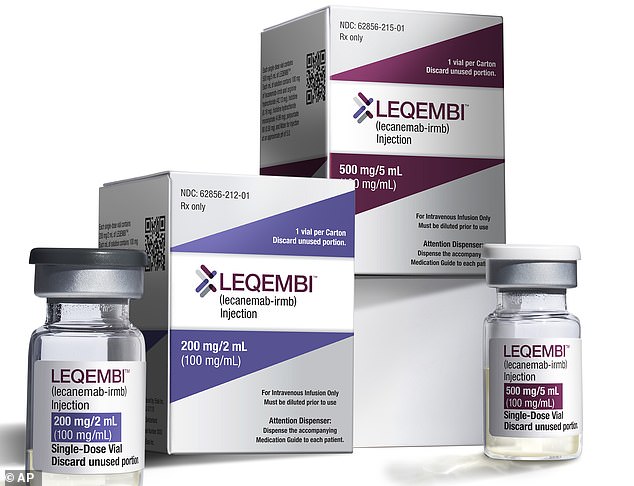
The Food and Drug Administration granted full approval for the most effective drug to attack Alzheimer’s disease in decades.
The decision from federal regulators follows a unanimous recommendation by neurologists at the agency last month and opens to door to broader health coverage sponsored by the federal government.
An estimated 6.5 million Americans 65 and older have Alzheimer’s disease and qualify for Medicare, the government-sponsored health insurance program for seniors, which will cover all but 20 percent of the total cost of the medication.
The list price for the medication, to be marketed as Leqembi, is set at $26,500 and patients enrolled in the program, whose annual income hovers around $29,000, will be on the hook for more than $5,000 per year.
The true number of people who will get the drug is a fraction of the total number of Alzheimer’s patients in the US because the IV medication is meant for people in the early stages of the disease’s progression, estimated to be around 640,000.

Approval of dementia medication Leqembi opens the door to hundreds of thousands of patients getting help, but the cost will be a major barrier to treatment




About 6.7 million Americans over 65 have Alzheimer’s and about 640,000 are in the early stages, meaning they might be eligible for the drug
How does the drug work?
Leqembi is a monoclonal antibody therapy given intravenously twice a month to reduce the toxic buildup of clumps of toxic amyloid proteins in the brain, a hallmark of Alzheimer’s disease, and slow symptoms of the mind-wasting disease.
In Alzheimer’s patients, the amyloid proteins build up and stick together to form different sized clumps that later become plaques in the brain.
Healthy brains are able to clear those plaques out, but in the context of Alzheimer’s disease the amyloid-beta protein deposits build up over time and form ‘sticky’ plaques in the brain. They are thought to disrupt communication between cells and activate the immune system, causing inflammation.
When the buildup of amyloid in the brain reaches a tipping point, it leads to the formation of tangles of a protein called tau.
The formation of these tangles disrupts the normal functioning of brain cells by disrupting the transport of essential molecules such as neurotransmitters involved in intercellular communication and nutrients such as glucose and oxygen.
The buildup of plaques and tau tangles damages synapses in critical regions of the brain over time, including the hippocampus which is crucial for the formation of memories, as well as the Entorhinal Cortex which relays sensory information from the outer cortex of the brain to the hippocampus.
That buildup also damages the parietal lobe of the brain involved closely with sensory perception, spatial awareness, and the ability to maintain attention.
But by reducing the buildup of sticky plaques, the IV drug was shown to slow down the pace of cognitive decline.
The drug slowed the rate of cognitive decline by 27 percent after 18 months, representing a slowdown of five to six months.
Who will be able to get it?
The FDA’s full approval of the drug opens the door to potentially millions, though the true number of people who will get it is considerably smaller because it is meant for those in the early stages of the disease, estimated to be between 360,000 and 640,000 people.
It will also depend on how much a person can afford to pay. Despite the fact that Medicare has expanded coverage of the drug beyond to those enrolled in clinical trials, the cost will still be prohibitively high for many.
The list price set by drugmakers Eisai in Tokyo and Biogen in Cambridge, Massachusetts was $26,500, creating a cost barrier that millions of potential beneficiaries would not be able to overcome.
But under Medicare coverage rules, those who qualify for the drug will be responsible for 20 percent co-insurance, meaning the government will cover all but 20 percent of the total cost.
While this represents a significant price cut, it still leaves hundreds of thousands of people, potentially more, responsible for about $5,300 annually.
That estimate does not include the high added costs of living with Alzhiemer’s, which more often than not means paying a caregiver to come the patient’s house or housing the patient in an assisted living facility long term so that they have round-the-clock care.
Why are experts downplaying it?
The panel of experts at the FDA determined last month that the benefits of the medication far outweighed the risks of taking it.
But some experts cast doubt on the usefulness of the drug. While one member of the panel, Dr Merit Cudkowicz called the clinical evidence ‘very clear’ and ‘very robust’, others voiced concerns about the significant health risks attached to the lab-made antibody.
Among those who received Leqembi in the trial, 17 percent had brain bleeding, compared with nine percent in the placebo group, and 13 percent had brain swelling, compared with just two percent of those given a placebo.
In an earlier study, about seven percent of trial participants dropped out due to adverse effects compared to less than three percent of placebo recipients.
Overall, 14 percent of people who received the drug suffered a serious adverse reaction in the trial compared to just 11 percent of those who did not get the drug.
The companies behind the drug, Eisai in Tokyo and Biogen in Cambridge, Massachusetts have said 13 trial participants died.
The drug will come with a ‘boxed warning’ because it can cause brain bleeding and swelling.
In an extended portion of the drug’s main trial three patient deaths were recorded, thought to be linked to the drug.
Around 21 per cent of trial participants who received the drug experienced brain swelling or bleeding, compared to 9 per cent of those who received a placebo.
The boxed warning also says that patients with two copies of a genetic variant that increases the risk of developing Alzheimer’s appear to be at a higher risk of complications.
Therefore genetic testing should occur – if possible – before a patient receives the drug, the warning reads.
Source: | This article originally belongs to Dailymail.co.uk